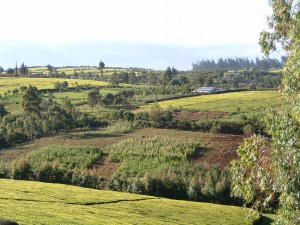This strikes close to home. The Ministry of the Environment in Kenya has instructed farmers in Central Province to cut down eucalyptus trees growing near water courses. Apparently, this constitutes “an attempt to lessen the impact of the drought that is ravaging the country,” because eucalypts are “thirsty.”
The mother-in-law has been managing (by coppicing) a small eucalyptus stand for years. The firewood is what keeps her — and us, when we visit — warm during the cold season. And she sells a few poles every now and then for extra cash. You can see how important gums and other exotic trees are around her place in the Limuru highlands in this picture:

Now, I’m all in favour of indigenous trees, but the seeds haven’t been available in sufficient quantities until recently (to say nothing of awareness and policies). And the hydrological case against eucalypts is subtle: they certainly use a lot of water, but they are efficient in its use, and a very valuable resource in many places.
It seems unfair to blame and penalize farmers for choosing eucalyptuses and Australian acacias when they needed to plant some trees many years back and those were the species that were available, and were being pushed. I hope the mother-in-law gets to keep her eucalypts, at least until she can get some grevilleas growing. We’ll need them when the cold comes.
Dear Luigi,
Fully support your comments on the economic value of eucalypts (acacias and grevilleas) in Kenya and east Africa more generally. You are correct in observing that eucalypts have very high water use efficiencies (viz wood produced per unit of water transpired).
In Ethiopia recently, a country which has suffered massive loss in native forest cover since mid last century, I observed the importance of exotic eucalypts, acacias, grevilleas in providing habitat and food for the country’s diverse but highly threatened birdlife.
Around your Linda’s mums place I saw there were quite a few of the native Prunus africana. I reckon this tree can grow quickly in Kenyan highlands if given a little care in first year — perhaps a commercial rotation of 15 years to provide income (bark for medicine and timber from main bole) and fuelwood from branches. This is also an excellent habitat tree for native wildlife.
Cheers,
Lex